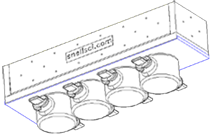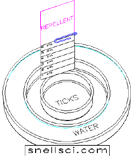Human Pest Testing
EPA Guidelines
- We have protocols to follow the EPA’s protocols (OPPTS) for testing many biting species.
- However, EPA currently has made such testing nearly impossible to conduct with the proper approvals. While this problem continues to be negotiated with EPA and various chemical companies, we have developed a range of protocols which simulate human testing.
Mosquito, Black Fly, Stable Fly, and other Biting Diptera Species
 Bite tests are conducted using our custom designed blood membrane system. Biting insects are contained inside ‘bite boxes’ and held on the treated membranes. Data confirms that the membranes are good representatives of the bite pressure on humans. The longevity of products can be proven by testing the membranes treated with ‘on-body’ products and tested over several hours
Bite tests are conducted using our custom designed blood membrane system. Biting insects are contained inside ‘bite boxes’ and held on the treated membranes. Data confirms that the membranes are good representatives of the bite pressure on humans. The longevity of products can be proven by testing the membranes treated with ‘on-body’ products and tested over several hours Snell Sci has developed a ‘repel-o-meter’ for testing the repellency of compounds such as treated fabrics when placed over human subjects as attractants
Snell Sci has developed a ‘repel-o-meter’ for testing the repellency of compounds such as treated fabrics when placed over human subjects as attractants- Adulticides can be tested as direct applications to insects, as treated surfaces, and as surface repellents
Flea/ Tick
 The repellency of ‘on-body’ products for ticks can follow EPA human testing protocols or a custom Snell Sci protocol using non-human methods. The EPA method can be unreliable depending on the compound being tested and the species of ticks tested. The Snell Sci non-human methods can be very reliable to compare different repellency formulations and actives.
The repellency of ‘on-body’ products for ticks can follow EPA human testing protocols or a custom Snell Sci protocol using non-human methods. The EPA method can be unreliable depending on the compound being tested and the species of ticks tested. The Snell Sci non-human methods can be very reliable to compare different repellency formulations and actives.- Flea repellents can also be tested using EPA protocols. Snell Sci also provides our own unique methods of testing flea repellents from a variety of non-human surfaces.
Lice
- Head lice and body lice can be tested with repellents and toxicants.
